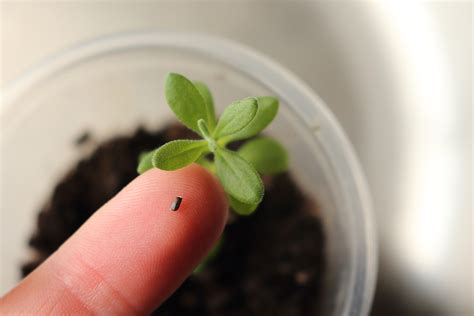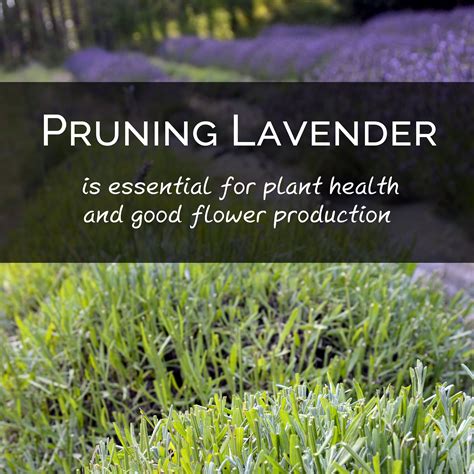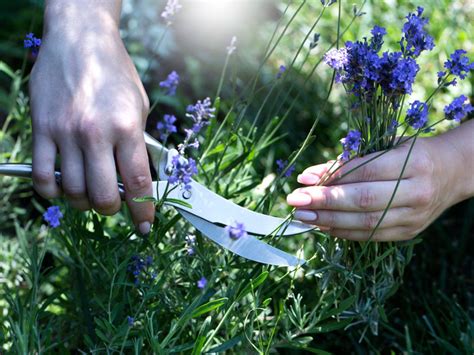Imagine stepping into a fragrant oasis, surrounded by lush fields of vibrant colors and enveloped in the intoxicating aroma of lavender. Transporting you to idyllic landscapes, lavenders have a long-standing reputation as one of the most versatile and captivating plants in existence. Delving into the realm of lavender cultivation opens up a world of endless possibilities, where with careful attention and dedication, you can witness the transformation of a humble seed into a stunning masterpiece.
Discover the secrets to nurturing these delicate yet resilient plants as we guide you through the essential steps to successful lavender cultivation. From understanding the different types and their unique characteristics to providing the optimal care, our comprehensive exploration will equip you with the knowledge and skills needed to embark on your own lavender-growing endeavor.
Unleash your creativity and indulge your senses as you immerse yourself in the art of lavender cultivation. Learn to navigate the intricate dance between soil, sunlight, and watering to foster robust growth and a bountiful harvest. Explore the wide range of lavender species, each possessing its distinct beauty and enchanting fragrance, providing an opportunity to curate a picturesque kaleidoscope of colors in your own garden.
Join us as we delve into the myriad of therapeutic and culinary applications lavender has to offer. From soothing oils and indulgent bath products to delightful culinary creations, you will unlock the full potential of this remarkable and versatile plant. Allow the captivating allure of lavender to ignite your imagination and embark on a journey of self-discovery and bountiful rewards as you embrace the art of growing and caring for lavender plants.
Choosing the Perfect Spot: Sunshine, Soil Quality, and Adequate Drainage

When it comes to successfully growing and caring for lavender plants, one of the most important factors to consider is selecting the right location. By providing the ideal conditions for your lavender, you can ensure that it thrives and produces beautiful blooms.
Sunshine, without a doubt, plays a vital role in the growth and development of lavender. These sun-loving plants thrive when exposed to full sunlight for at least six to eight hours a day. Therefore, it is essential to choose a location that receives ample sunshine throughout the day, such as a south-facing area in your garden or a spot that is not obstructed by tall trees or buildings.
Another crucial aspect to consider is the quality of the soil in the chosen location. Lavender plants prefer well-drained soil that is slightly alkaline in nature, with a pH level between 6.7 and 7.3. It is advisable to test the pH level of your soil before planting lavender, as acidic soil can hinder the plant's growth. If your soil is too acidic, you can amend it by adding dolomitic lime or organic matter, such as compost or aged manure, to raise the pH level.
In addition to soil quality, proper drainage is essential for the success of lavender plants. Lavender does not tolerate waterlogged conditions, as the roots may rot and the overall health of the plant may deteriorate. Ensuring that the chosen location has good drainage, either naturally or through methods such as raised beds or adding sand or gravel to the soil, will help prevent excess moisture from accumulating around the roots.
| Key Factors for Choosing the Right Location: |
|---|
| Sunshine: Full sunlight for 6-8 hours a day is ideal. |
| Soil Quality: Well-drained and slightly alkaline soil (pH level 6.7-7.3) is preferred. |
| Drainage: Adequate drainage to prevent waterlogged conditions is crucial. |
By carefully considering these key factors – sunshine, soil quality, and drainage – you can select the perfect location for your lavender plants. Remember, a well-chosen spot will provide the optimal environment for your lavender to flourish and grace your garden with its fragrant, vibrant blossoms.
Selecting the Perfect Lavender Variety: Aromas, Colors, and Growth Habits
When it comes to choosing the right lavender variety for your garden, there are several factors to consider. Each lavender variety possesses its own unique set of qualities, including distinct aromas, vibrant colors, and specific growth habits.
One of the key factors to consider when selecting a lavender variety is the aroma. Different lavender varieties produce aromas that can range from sweet and floral to herbal and earthy. Some lavender varieties, such as English lavender, emit a soothing and relaxing scent, making them a popular choice for aromatherapy and culinary uses. On the other hand, French lavender tends to have a stronger, more medicinal fragrance, making it ideal for medicinal and therapeutic purposes.
Another important aspect to consider is the color of the lavender flowers. Lavender plants come in a variety of hues, including shades of purple, blue, pink, and white. The color of the flowers can add a vibrant splash to your garden and create a visually pleasing landscape. Additionally, some lavender varieties, such as Spanish lavender, have unique flower structures, like tufted petals or elongated bracts, which further enhance their ornamental value.
In addition to aroma and color, the growth habit of the lavender variety is an essential consideration. Lavender plants can exhibit various growth habits, ranging from compact and bushy to tall and spiky. If you have limited space or prefer a neat appearance, choosing a dwarf or compact lavender variety would be a suitable option. On the other hand, if you want to create a more natural and rustic look or intend to use lavender for hedges or borders, selecting a tall and upright variety would be more appropriate.
Ultimately, the selection of the perfect lavender variety depends on your personal preferences and the intended purpose of the plant. Whether you're looking for aromatic lavender to add fragrance to your garden or vibrant lavender colors to enhance your landscape, understanding the different aromas, colors, and growth habits of lavender varieties will help you make an informed choice.
Timing and Spacing for Planting Lavender Seeds or Seedlings

Proper timing and spacing are crucial factors to consider when planting lavender seeds or seedlings. By understanding the ideal conditions for these plants, you can ensure their successful growth and development.
Timing:
- Start planting lavender seeds indoors in the early spring, approximately 8 to 10 weeks before the last frost date.
- For areas with mild climates, you can also sow seeds outdoors in the fall, allowing them to overwinter naturally.
- When planting lavender seedlings, the best time is in the late spring or early summer, after the threat of frost has passed.
Spacing:
- Provide enough space between lavender plants to allow for proper air circulation, which helps prevent disease and promotes healthy growth.
- For compact varieties, maintain a spacing of approximately 9 to 12 inches (23 to 30 centimeters) between each plant.
- If you have larger lavender varieties, increase the spacing to about 12 to 18 inches (30 to 45 centimeters).
- When planting lavender in rows, ensure a spacing of approximately 36 inches (91 centimeters) between each row to facilitate easy access for maintenance.
By following the appropriate timing and spacing guidelines for planting lavender seeds or seedlings, you can create a thriving lavender garden that will fill the air with its delightful scent and add beauty to your outdoor space.
Watering Lavender: Achieving the Perfect Moisture Balance
Properly watering your lavender plants is essential for their overall health and successful growth. Finding the right balance between keeping the roots hydrated and avoiding waterlogged soil can be challenging but crucial for the longevity of your plants.
- Consistency is key when it comes to watering lavender. While it may be tempting to give them frequent watering, lavender actually thrives in well-draining soil.
- Overwatering can lead to root rot and the demise of your lavender plants. It is important to monitor the moisture levels of the soil to prevent soggy conditions.
- One effective approach is to water deeply but infrequently. This encourages the roots to grow deeper into the soil, enhancing their overall resilience.
- During the establishment phase, lavender plants require regular watering to establish a strong root system. However, once they are well established, they are more drought-tolerant and can withstand longer periods without watering.
- Keep in mind that different environmental factors, such as temperature and humidity, can influence the watering needs of your lavender. Adjust your watering schedule accordingly to meet these requirements.
- Consider using mulch around your lavender plants to help retain moisture in the soil and prevent evaporation. This can also assist in maintaining a consistent soil temperature.
- When watering your lavender, direct the water near the base of the plant to ensure the roots receive the moisture they need. Avoid getting the foliage wet, as this can promote the development of fungal diseases.
By finding the right balance in watering your lavender plants, you can create an optimal growing environment that promotes their vitality and beauty. Remember, maintaining proper moisture levels is a key factor in the overall care and success of your lavender garden.
Fertilizing and Pruning Lavender: Promoting Healthy Growth and Flowering

Enhancing the vitality and blooming potential of your lavender plants involves two crucial practices: fertilizing and pruning. By implementing a proper fertilization routine and executing precise pruning techniques, you can encourage robust growth, enhance flowering, and ultimately ensure the health and longevity of your beloved lavender plants.
Fertilizing:
When it comes to fertilizing lavender, it is essential to apply a balanced and controlled approach. Excessive nitrogen can lead to lush foliage with reduced flowering, while insufficient nutrients may result in stunted growth. To strike the right balance, opt for a slow-release, organic fertilizer with comparable proportions of nitrogen, phosphorus, and potassium.
Start fertilizing lavender plants in early spring, right after the last frost date in your area. Sprinkle the fertilizer around the base of the plants, taking care not to let the granules directly touch the stems. Gently work the fertilizer into the top inch of the soil, ensuring it is well-distributed. A thorough watering afterwards helps to activate the nutrients and prevent potential root burn.
During the first year, apply fertilizer once every two months, gradually reducing the frequency to once during the active growing season in subsequent years. Remember to follow the manufacturer's instructions regarding the exact application rate and frequency, as different products may have specific recommendations.
Pruning:
Pruning is an essential aspect of lavender care that not only promotes healthy growth but also encourages abundant flowering. Regular pruning helps maintain a compact and tidy appearance while stimulating the plant's overall vigor.
Begin pruning in early spring, just as new growth starts to emerge. Trim back about one-third of the plant's height, ensuring that you leave some green foliage on each stem. Avoid cutting back into old woody growth as this may inhibit new growth. The pruned clippings can be gathered and used for craft projects, potpourri, or even culinary purposes.
To prevent the plant from becoming excessively woody, a light trimming after the first flowering flush is recommended. Additionally, for certain lavender varieties that tend to become leggy, a moderate shearing in mid-summer can help maintain a more compact form.
It is important to note that lavender plants vary in their pruning requirements depending on the specific variety and intended use. Therefore, it is advised to research and understand the pruning needs of your lavender plants before embarking on this practice, as improper pruning techniques can harm or even kill the plant.
In conclusion, through appropriate fertilization and diligent pruning, you can nurture your lavender plants to thrive and flourish. Providing them with the right nutrients and regular pruning maintenance will not only promote strong growth but also facilitate an abundance of aromatic blooms, allowing you to enjoy the beauty and fragrance of lavender in your garden for years to come.
Dealing with Common Lavender Pests and Diseases
When it comes to cultivating and maintaining a thriving lavender garden, it is crucial to be aware of the various pests and diseases that can affect your plants. Although lavender is known for its resilience, it is still susceptible to certain issues that can hinder its growth and overall health.
Pests
One of the common challenges faced by lavender plants is the presence of pests. These small organisms have the potential to damage leaves, stems, and flowers, ultimately compromising the plant's vitality. Some of the pests that can be detrimental to lavender include aphids, spider mites, and whiteflies.
Aphids are small insects that feed on sap, causing leaves to become distorted and stunted. Spider mites, on the other hand, are tiny arachnids that create fine webs and suck plant juices, leading to a weakened appearance. Lastly, whiteflies are small, flying insects that excrete sticky honeydew, attracting mold and attracting more pests.
Prevention and control measures:
To protect your lavender plants from these pests, it is essential to maintain good garden hygiene. Regularly inspect your plants for any signs of infestation and promptly remove any affected leaves or stems. Additionally, consider implementing natural pest control methods such as introducing beneficial insects like ladybugs or using insecticidal soap.
However, it's important to note that not all insects are harmful to lavender. Some beneficial insects, like bees and butterflies, play a vital role in the pollination process and should be encouraged in your garden.
Diseases
Lavender plants may also be susceptible to various diseases that can weaken or even kill them if left untreated. Common diseases that affect lavender include root rot, powdery mildew, and leaf spot.
Root rot is a fungal disease that affects the plant's root system, causing it to rot and eventually leading to the death of the plant. Powdery mildew, on the other hand, is a fungal infection that appears as a white powdery substance on the leaves, hindering photosynthesis and potentially weakening the plant.
Leaf spot is another fungal disease that causes small brown or black spots on the leaves, potentially leading to defoliation and reduced overall plant health.
Prevention and treatment strategies:
Preventing diseases in lavender plants involves providing optimal growing conditions. Ensure that your lavender has well-drained soil and receives adequate sunlight and air circulation. Avoid overwatering and overcrowding, as these conditions can lead to the development of fungal diseases.
If you notice any signs of disease, it is crucial to take action promptly. Prune affected plant parts, dispose of them properly, and consider applying fungicides specifically formulated for lavender plants.
By staying vigilant and implementing appropriate preventive measures, you can effectively deal with common pests and diseases that may threaten your lavender plants' health and ensure a thriving and fragrant garden for years to come.
Harvesting and Using Lavender: Enjoying the Fruits of Your Efforts

Once your lavender plants have matured and flourished, it's time to reap the rewards of your hard work. In this section, we will explore the process of harvesting lavender and how to make the most of this versatile and fragrant herb.
Harvesting lavender involves carefully cutting the flower stems at the right time to ensure optimal potency and fragrance. It's important to wait until the flowers have fully bloomed and reached their peak before harvesting. This ensures that you capture the essential oils at their highest concentration, giving you the best aroma and flavor.
After harvesting, you can use lavender in various ways. The dried flowers make beautiful and fragrant additions to potpourris, sachets, and homemade bath products. The essential oils extracted from lavender can be used in aromatherapy, as well as for creating scented candles, soaps, and beauty products.
In addition to its aromatic qualities, lavender also offers a range of health benefits. It can help in relieving stress and anxiety, promoting relaxation, and improving sleep quality. By incorporating lavender into your daily routine, you can create a calm and rejuvenating environment.
When it comes to using lavender, the possibilities are endless. From culinary delights like lavender-infused cookies and teas to natural household cleaners and insect repellents, this versatile herb can enhance various aspects of your life.
In conclusion, harvesting lavender marks the culmination of your efforts in growing and caring for this resilient plant. By carefully harvesting at the right time and exploring the many ways to use lavender, you can fully enjoy the fruits of your labor and experience the myriad benefits that lavender has to offer.
Preparing Your Lavender Plants for Winter: Ensuring Their Survival in Cold Weather
As the colder months approach, it's essential to take the necessary steps to protect your cherished lavender plants and help them endure the harsh winter conditions. In this section, we will explore the art of overwintering lavender, focusing on the key practices that will contribute to the plant's resilience and longevity.
Understanding the Vulnerability of Lavender:
Lavender, with its delicate blooms and aromatic foliage, requires special attention when faced with the cold temperatures of winter. The plant's unique characteristics make it susceptible to damage, including frostbite, root rot, and general decline. By implementing proper overwintering techniques, you can fortify your lavender plants against these threats and maximize their chances of thriving in the following growing season.
Preparing the Soil and Roots:
One crucial aspect of overwintering lavender is ensuring that the soil and roots are adequately prepared. Begin by alleviating any compacted soil and ensuring proper drainage to prevent waterlogging. Consider adding organic matter, such as compost, to improve soil structure and provide essential nutrients. Additionally, gently prune any dead or damaged branches and remove any weeds or debris surrounding the base of the plant.
Providing Adequate Insulation:
Another critical step in safeguarding lavender plants during winter is providing them with sufficient insulation. Start by adding a layer of mulch around the base of the plant, covering the root zone. This organic material will help regulate soil temperature and retain moisture, preventing excessive freezing and drying. Additionally, consider using protective coverings, such as burlap or frost blankets, to shield the plants from harsh winds and extreme cold weather.
Monitoring and Adjusting Moisture Levels:
Proper moisture management is essential in overwintering lavender, as both excessive dryness and excessive moisture can harm the plant. Monitor the soil moisture regularly, adjusting watering practices as needed to maintain a slightly moist but not saturated environment. Be cautious not to overwater, as this can lead to root rot. During prolonged dry spells, consider providing supplemental moisture to prevent dehydration.
Protecting From Frost and Cold Snaps:
Lavender is highly sensitive to frost and extreme temperature drops, which can cause severe damage or death. Stay vigilant during cold snaps and be prepared to protect your plants. Consider covering them with breathable materials overnight, like blankets or tarps, to shield them from freezing temperatures. Additionally, grouping potted lavender plants together or moving containers indoors can provide an extra layer of protection.
Extra Care for Newly Planted Lavender:
If you have recently planted lavender, it is crucial to provide extra care during their first winter. These young plants have a more challenging time adapting to the cold, so taking precautionary measures is essential. Consider applying a layer of mulch around the base of the plant, protecting it from freezing temperatures and insulating the fragile roots.
By following these guidelines for overwintering lavender, you can ensure that your beloved plants remain healthy, vibrant, and prepared to flourish when warmer weather returns. Taking the time to provide the necessary care and protection will reward you with an abundance of fragrant lavender blooms for years to come.
FAQ
What is the best time to plant lavender?
Lavender should be planted in the spring or fall when the weather is mild. This allows the plant to establish its roots before the extreme heat of summer or the freezing temperatures of winter.
How much sunlight does lavender need?
Lavender plants thrive in full sun and require at least 6-8 hours of sunlight each day. Be sure to choose a location for planting that receives ample sunlight.
Can lavender tolerate drought conditions?
Yes, lavender is known for its ability to tolerate drought conditions. Once established, lavender plants do not require frequent watering and can survive with minimal rainfall. However, be sure to give newly planted lavender enough water to help it become established.



